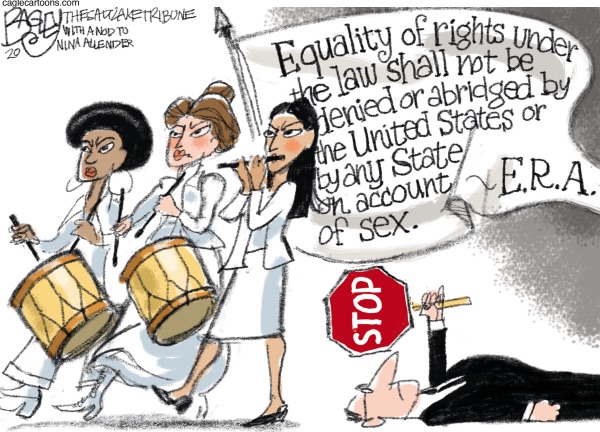Women’s Equality Day
It’s Time to Meet the Moment!

Here we are, living through the most tumultuous of times. Decision-makers are faced with an array of complex problems and dilemmas that could not have been predicted, and all at the same time. Every organization needs the smartest people to take their place at the table to not only respond to the pressing problems of the day but also to formulate the right questions and make decisions that will shape our future. That requires the organization to recruit, hire, and promote diverse people to sit at that table, including women who have been hardest hit by the consequences of the pandemic.
The glass ceiling persists as an invisible barrier blocking women’s vertical ascent into those top levels of leadership and decision-making. These often subtle but persistent barriers are obstacles to women’s advancement, underpinned by discriminatory, conscious as well as unconscious, practices, attitudes, and assumptions based on outdated gender roles. Regarding the obstacles to women achieving parity with men, the numbers are shocking when we consider there are 3.43 million more females than males. Women are educated, ready to move into leadership roles, earning more baccalaureate degrees than men and 53.1 percent of the total post-graduate degrees. Women are 37 percent of all lawyers and more than 50 percent of all doctors. According to a new Pew Research Center survey on women and leadership, most Americans find women indistinguishable from men on key leadership traits such as intelligence and capacity for innovation, with many respondents saying they’re stronger leaders than men in terms of being compassionate and organized leaders.
Women’s Equality Day provides the opportunity for organizations across sector to take a serious look at just how far women have really come, and to take bold action to reassert women’s seat at table.
During the past two years, COVID changed everything about the way work was produced and workplaces were organized. Practices, assumptions, and attitudes were tested across the board. Even those formerly successful, progressive, and flexible organizations with diversity plans in place were challenged to be nimble. For instance, as a result of the ongoing pandemic, the global economy contracted by 3.3 percent in 2020. Of the 18.1 million people unemployed in the U.S. as of June 2022, 11.4 million (63 percent) were unable to work because their employer closed or lost business due to the pandemic. Shutdowns and disruptions in supply chains impacted the world, and estimates show the equivalent of 255 million full-time jobs worldwide were lost due to COVID-19. Employers might well be tempted to back down from their gender diversity goals just to survive.
A Closer Look
Women are a critical factor in the country’s GDP. In a report on gender equality, Reuters indicates that the U.S. economy could get a $1 trillion boost over the next 10 years if female labor market participation grew to the levels seen in other developed economies. Timing could not be worse to ease up on gender diversity goals. Given the crises, exacerbated by the lack of paid maternity leave and access to child care, the public learned that women’s employment fell by a staggering 13.4 million jobs over three months, from February 2020 to April 2020, with women losing 1.5 million more jobs than men during that period. In a report about the pandemic-induced economic crisis, produced by The Center for American Progress, we learned that women were harmed the most, with women of color bearing an even greater burden due to their overrepresentation in low-income, front-line, and essential jobs in the service industry, manufacturing, and retail sector.
The early months of the coronavirus pandemic raised fears of a reversal in whatever progress women have made. Rightfully so. Millions were pushed out of work due to the resulting recession; others were pulled from the labor force to attend to family needs as schools and child-care centers closed their doors. Job losses had a disproportionate impact on women’s employment. Women might well start their second job at 8 a.m., juggling home responsibilities and/or caregiving roles for aging parents. Likely in order to maintain their mental and physical health, more than 1.1 million women dropped out of the workplace altogether as a result of COVID.
Achieving Workplace Advancement
For those women who remained in the workplace, the disparity still remains a front-burner issue. Hard to believe that in 2020, women who worked full-time year-round were paid an average of about 83 cents for every dollar a man earned. Any discussion of women’s employment must be firmly rooted in an awareness of this continued, pervasive wage gap. Bold policy reforms therefore are needed to mitigate the impact of COVID on women’s employment, to strengthen their long-term economic security. Research supports this need for reform based on these workplace issues that hinder women’s advancement:
- Insufficient access to high-quality childcare and caregiving support
- Lack of access to flexible and remote work for women at every level
- The continuation of a gender pay gap without HR scrutiny to address the issue
- Women’s lack of access to sponsors or mentorship programs
- Unconscious bias in recruitment, hiring, and promoting women
- The need to rethink the annual review, instead fostering regular feedback to women about performance vis-à-vis career goals
- Training for managers in how to facilitate advancement for diverse women based on their talents, contributions, interests, and demonstrated abilities
In addition to working women’s stress created by the pandemic, new challenges to corporate decision makers emerged related to accessing out-of-state health care and reproductive services after the Supreme Court released a ruling that overturned Roe v. Wade. No surprise that companies are in the process of assessing how best to support women’s needs, given the legal complexities involved. Major U.S. companies, including Meta, JPMorgan Chase, Apple, Citigroup, Salesforce, Yelp, Microsoft, and Disney have said they will cover costs such as travel for employees who seek legal abortions outside their home state. Uber and Lyft said that they would provide legal support for drivers if they faced lawsuits for driving passengers to get an abortion.
Seize the Opportunity
Given this context, Women’s Equality Day on August 26 offers organizations the opportunity to acknowledge and shine the spotlight on women’s contributions to the services they provide and the talents they contribute to economic productivity and viability. On Women’s Equality Day, we all have the opportunity to recognize women in diverse and meaningful ways, including:
- Hosting a special meeting or meal to honor women in the organization who demonstrated leadership in some capacity
- Highlighting the faces and contributions of working women in one’s organization through appreciative internal emails or on social media, especially those who have gone “above and beyond” during the past two years
- Releasing an HR report indicating the company’s Action Steps to ensure pay equity along with a Gender Diversity Initiative to ensure women are given opportunities to advance into leadership roles
- Awarding a donation to a local charity or club that addresses girls or women’s social or academic needs
- Organizing a funded Women’s Network within the organization with release time for meetings in person or via teleconferencing
- Ensuring training is available in relevant skills needed for advancement within the organization such as: communication, strategic planning, technical, project management, data analytics, metrics, and finance skills.
Do the Right Thing
Actively participating in Women’s Equality Day can be just the beginning of a long-term commitment to upending inequality in corporate America’s own backyard. Every organization needs to retain and cultivate all talent from within, and that means ensuring a level play field. As management guru Peter Drucker advised, “Management is doing things right. Leadership is doing the right things.” Executives are advised to consider how their organization should celebrate Women’s Equality Day, whether with a party or a plan for change.
Lois Phillips PhD is a communications consultant with an interest in gender differences in leadership style.



